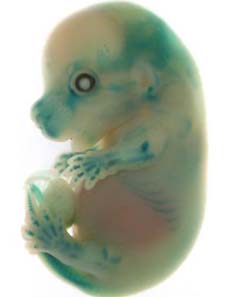Gene the extinct tiger
70 years after the extinction of the Tasmanian tigers, its DNA has been "revived" by Australian scientists inside the rat's body.

For the first time in the world, the gene for the extinct Tasmanian tiger was injected into the mouse embryo.(Photo: smh.com.au)
This is the first time that an extinct animal's DNA can function within a living organism. This technique can help us discover more about dinosaurs or ancient Neanderthals .
To carry out the study, scientists from the University of Melbourne (Australia) and the University of Texas (USA) have extracted a sample of a Tasmanian tiger's DNA over 100 years old, stored in ethanol at a museum, and injected into mouse embryos to study cartilage development.
As a result, they discovered the Col2A1 gene of the Tasmanian tiger with similar functions in the development of cartilage and bone while in mice. This result promises to develop new biomedical technology to create genes that can help regenerate cartilage.
The Tasmanian tiger is a mysterious predator hunted to extinction in the wild in the early 20th century. By 1936, the Tasmanian tigers were eventually known to die in the Hobart zoo.
According to scientists, at the present time, when the rate of extinction of species increases at an alarming rate, the study will help to better understand the species that are completely extinct, from which can access to their biodiversity.
Video of the last Tasmanian tiger:
- About to revive the extinct Persian tiger
- Tasmanian tiger extinct due to human error
- Sumatran tiger in Jambi may soon be extinct
- 12 interesting facts about tigers that amaze you
- Amur the Tiger has escaped extinction
- The Tasmanian tiger is about to be
- Science confirmed 9 species of tigers on Earth, 3 extinct species
- Discover the oldest tiger species on Earth
- Famous extinct animals
- Decoding the gene of the big cat family line
- 10 strange extinct animals
- Amur's tiger reappeared in China
 Why do potatoes have eyes?
Why do potatoes have eyes? 'Tragedy' the world's largest carnivorous life: Death becomes ... public toilet
'Tragedy' the world's largest carnivorous life: Death becomes ... public toilet Tomatoes were once considered 'poisonous' for 200 years
Tomatoes were once considered 'poisonous' for 200 years Detecting microscopic parasites on human face
Detecting microscopic parasites on human face